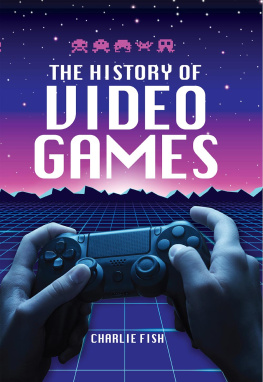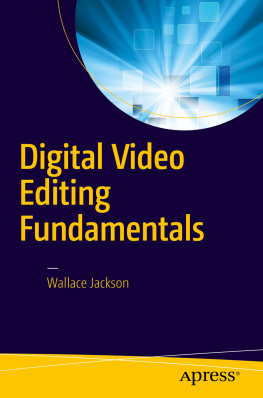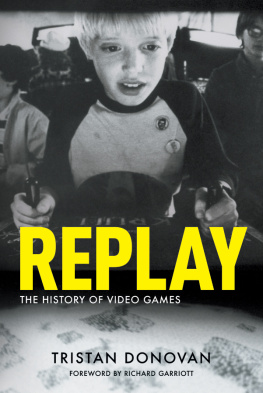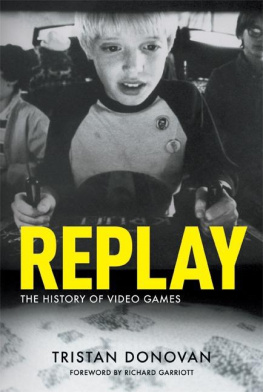Meigh-Andrews - A History of Video Art
Here you can read online Meigh-Andrews - A History of Video Art full text of the book (entire story) in english for free. Download pdf and epub, get meaning, cover and reviews about this ebook. publisher: Bloomsbury Publishing, genre: Non-fiction. Description of the work, (preface) as well as reviews are available. Best literature library LitArk.com created for fans of good reading and offers a wide selection of genres:
Romance novel
Science fiction
Adventure
Detective
Science
History
Home and family
Prose
Art
Politics
Computer
Non-fiction
Religion
Business
Children
Humor
Choose a favorite category and find really read worthwhile books. Enjoy immersion in the world of imagination, feel the emotions of the characters or learn something new for yourself, make an fascinating discovery.
- Book:A History of Video Art
- Author:
- Publisher:Bloomsbury Publishing
- Genre:
- Rating:3 / 5
- Favourites:Add to favourites
- Your mark:
- 60
- 1
- 2
- 3
- 4
- 5
A History of Video Art: summary, description and annotation
We offer to read an annotation, description, summary or preface (depends on what the author of the book "A History of Video Art" wrote himself). If you haven't found the necessary information about the book — write in the comments, we will try to find it.
A History of Video Art — read online for free the complete book (whole text) full work
Below is the text of the book, divided by pages. System saving the place of the last page read, allows you to conveniently read the book "A History of Video Art" online for free, without having to search again every time where you left off. Put a bookmark, and you can go to the page where you finished reading at any time.
Font size:
Interval:
Bookmark:
A History of Video Art
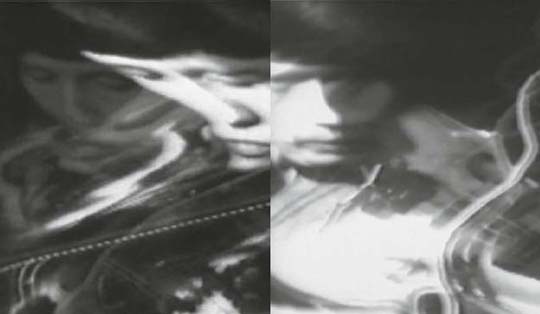
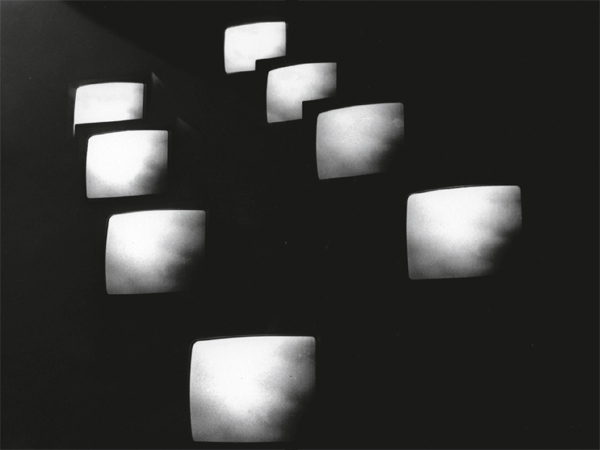
Chris Meigh-Andrews
A History of Video Art
2nd Edition

CONTENTS
Monitor, Steve Partridge, UK, 1975; Television Delivers People, Richard Serra and Carlotta Fay Schoolman, USA,1973; This is a Television Receiver, David Hall, UK, 1974; Vertical Roll, Joan Jonas, USA, 1972; The Video Touch, Wojciech Bruszewski, Poland, 1977; Marca Registrada [Trademark], Leticia Parente, Brazil, 1975
Keeping Marlene Out of the Picture, Eric Cameron, Canada, 1973; Technology/ Transformation: Wonder Woman, Dara Birnbaum, USA, 1979; With Child, Catherine Elwes, UK, 1984; Blue Monday, Duvet Brothers, UK, 1984; Der Westen Lebt [The Western Lives], Klaus vom Bruch, West Germany, 1983; Sztuka To Potega [Art is Power], Josef Robakowski, Poland, 1985
Monument, Ture Sjlander and Lars Weck, Sweden, 1967; Merging-Emerging, Peter Donebauer, UK, 1978; The Reflecting Pool, Bill Viola, USA, 19779; Obsessive Becoming; Daniel Reeves, UK/USA, 1995; Art of Memory, Woody Vasulka, USA, 1987; Juste le Temps, Robert Cahen, France, 1983; Neo Geo: An American Purchase, Peter Callas, Australia, 1989
De La, Michael Snow, Canada, 1971; Il Nuotatore, Studio Azzurro, Italy, 1984; Television Circle, Judith Goddard, UK, 1987; The Situation Envisaged: The Rite II, David Hall, UK, 1988; Tall Ships, Gary Hill, USA, 1992; AIEUONN Six Features, Takahiko Iimura, Japan, 1999
Turbulent, Shirin Neshat, Iran, 1998; Wild Boy, Guy Ben-Ner, Israel, 2004; Shan Pipe Band Learns the Star Spangled Banner, Bani Abidi, Pakistan, 2004; 30x30, Zhang Peili, China, 1998; Virus, Churchill Madikida, South Africa, 2005
Television Workshops: Broadcast and Cable; Closed-circuit TV; Sound and Picture: Colour and Monochrome; Relationship to Sound, The picture signal, the camera image, recordings and tape
New Technologies: Freedom from History; Performance, video, intimacy and liveness. Ethnicity, sexuality, race and issues of representation, access and visibility; Alternative means of distribution and exhibition
Video Installation: Relationships between Images and Space; Multi-channel video non cinematic space?; Video Sculpture; Projection installation: video without the box: Breaking the frame.
Accessible Digital Effects; From Analogue to Digital; Computers, Non-linear Editing and Digital Video; New video formats and computer software; The Database and Interactivity: new narrative possibilities; High-definition video; Video and the world wide web
Convergence: Recent Artists Video and Blurring of Film and Video; Conclusion and Summary
This edition of A History of Video Art has developed directly out of the original edition, first published in 2006. In writing the original, I had wanted to try to provide a guide to the background and genesis of artists video as I had experienced it, and this is still the primary purpose of the book. Encountering artists video in the early 1970s I became captivated and enthralled by the swiftly developing technology and the challenging theoretical, cultural and political context, and inspired by the passionate commitment of many artists to the communicative power and creative potential of the medium.
In the early days video was perceived as a medium on the outside technically inferior to film, not suitable for broadcast, difficult to show in the gallery and yet so clearly offering something that other media did not or could not. Video had a unique and compelling immediacy and with the introduction of the Portapak, its instantly replayable image and sound made it ideal for personal experimentation. For artists seeking new possibilities, video offered something equivalent to an audio-visual sketchbook, and additionally could be operated by a single person in just about any location or situation. As portable video recorders and cameras become less expensive and more reliable and as the image and sound quality improved and presentation methods become more practical, its advantages and strengths become increasingly obvious to those who had initially been sceptical even hostile to its potential.
The first edition of this book had grown out of my own experience with all of this as a practicing artist and as one who was seeking to make sense of its complex trajectory; both personally and as a teacher attempting to communicate these ideas to other developing artists. My own early experience with artists video had been very much a transatlantic one; meeting artists who worked with the medium in the 1970s in the USA and Canada before coming to the UK to study and become involved in the London video art community. I became aware of the personal networks of artists, curators and activists involved and how these were crucial to the development of the art form.
The book began as PhD research into the context and background of my own art practice and was completed in 2001 under the watchful and patient eye of AL Rees at the Royal College of Art, with additional input, advice and encouragement from Prof. Malcolm Le Grice. The thesis was not in any sense suitable for publication and developing it into something that might be of use to others took me nearly five years. (Although not all of that time was spent writing, as I was determined not to stop making and exhibiting my own work!)
My own experience as an artist working with the medium across this period was that the limitations and capabilities of the technology that I was able to access had had an impact on the ideas, content and form of the work I was able to make, as well as on how it was perceived, and this was something I also observed in the work of my colleagues and peers. These insights and observations have had an impact on my approach to writing and structuring this book.
A History of Video Art is divided into three main sections: a discussion of the historical and critical context in which artists video developed and evolved; an examination of some representative works in relation to both technical and critical context, and a final section which attempts to examine artists video in relation to a period of rapid technological change. I have retained this structure in the new edition because it still seemed to offer a way to organize a very complex and diverse set of concerns, and I felt that this was still the best way to try to communicate and to initiate other alternative approaches and investigations. I remain convinced that there is a need for many parallel historical narratives in the history of any subject, and hence the title remains A History of Video Art. This is simply one of many possible historical surveys, and should be seen in this light. I wanted to encourage readers to engage in the development of their own research and to form and develop their own understanding and perceptions, perhaps as a direct result of reading this book,
This new edition includes changes and corrections to errors and omissions present in the first edition and I would like to thank those artists and readers who have made suggestions and pointed out mistakes and inaccuracies. This edition has been expanded to include brief summaries of the development of the genre in a number of countries Japan, Australia, China, India and Brazil as well as discussions of new works by artists working in countries not previously covered, such as South Africa, Brazil, Japan, Pakistan and Israel. These are of course simply examples, as there are now many countries in which artists video is made and shown. I wanted, within the limitations of the book to give a sense of the truly international scope of artists video, and the way in which influences and ideas have spread and interacted.
Next pageFont size:
Interval:
Bookmark:
Similar books «A History of Video Art»
Look at similar books to A History of Video Art. We have selected literature similar in name and meaning in the hope of providing readers with more options to find new, interesting, not yet read works.
Discussion, reviews of the book A History of Video Art and just readers' own opinions. Leave your comments, write what you think about the work, its meaning or the main characters. Specify what exactly you liked and what you didn't like, and why you think so.




